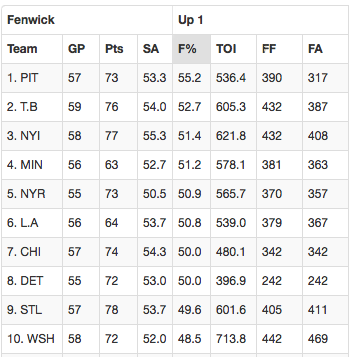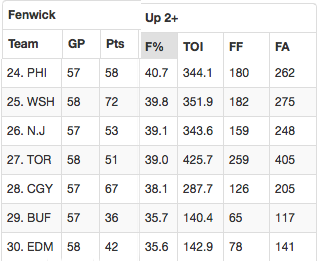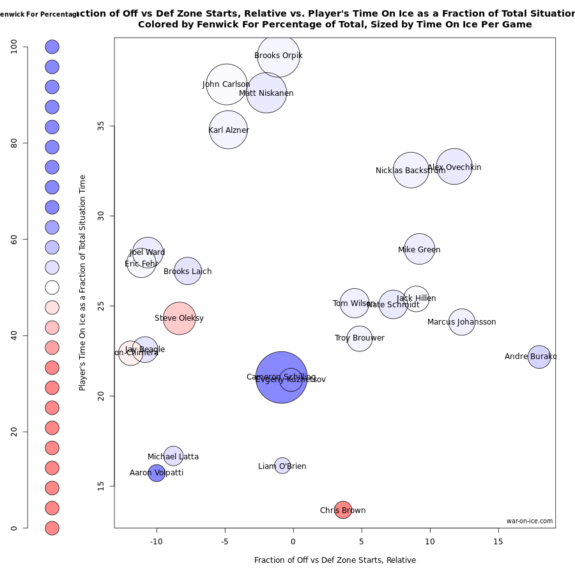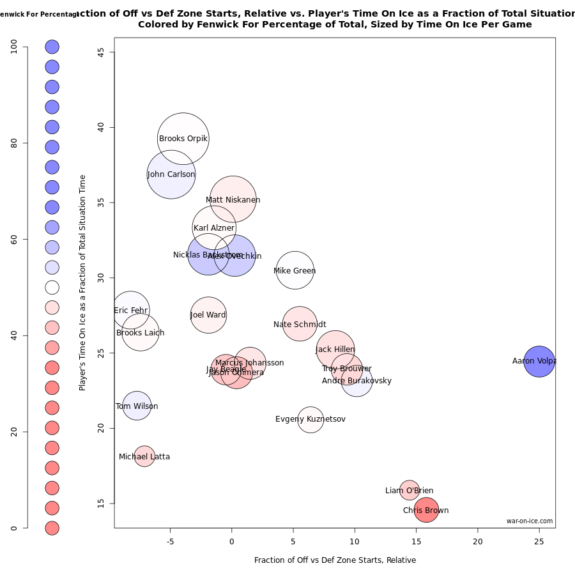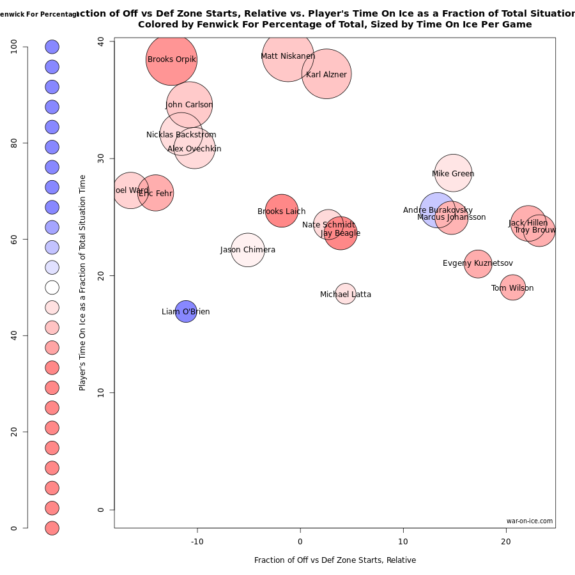The Capitals are a very dangerous hockey team. They play in a tough Metropolitan Division, where four teams have really come out and proven that they can be a playoff threat: The New York Islanders, the Pittsburgh Penguins, the New York Rangers, and, of course, Washington.
These teams obviously frequently play with a lead. But the way a team approaches the game after they take the league can vary.
Teams that take a lead tend to cut back on offense and focus a little more on their defensive side of the game. That makes sense. You’re coached from the time that you are little that you should focus on protecting the lead first and foremost. And it’s the opposite if you are down. A team that is down by a goal or two will be more aggressive offensively so that they can get back in the game. It’s obvious, but it’s also proven. Tom Awad found in his score effects study in Hockey Abstract that teams across the league in the 2013-2014 season that were down by two or more goals took on average 31.5 shots per 60 minutes of 5 on 5 play. And teams that were ahead by two or more goals took 25.4 per 60 minutes of 5 on 5 play. And the shots taken by teams that were down by two goals were also taken less accurately (7.54 percent), and shots taken by teams that were up by two or more goals. Why? Because teams that are down become more desperate for goals, taking more shots out of desperation and less accurate shots. Teams that are up pick and chose when to shoot because it’s not as high of a priority, and they are also playing against teams that are not focusing on defense. The same trend can be found on one-goal leads or one-goal deficits to a lesser degree.
So, theoretically, when a really good team takes a one or two-goal lead, they should be able to keep the opposition from shooting the puck as little as possible, causing the opposition to have as little scoring chances as possible.
The New York Islanders, the Pittsburgh Penguins and a lot of really successful teams this season do an excellent job of out playing the opposition when they have a lead. The New York Rangers do a pretty good job at it too. The Capitals do not do that great of a job at it.
Ahead By One
Ok, saying that the Capitals don’t do a very good job at outplaying the opposition might have been a little dramatic. When they are ahead by one, they actually do a decent job at maintaining possession and creating opportunities for themselves.
We can get an idea on how well the Caps, or any team in general, do when they are up by one or any other score situation by looking at the Puck on Net website. This allows us to see how much teams possess the puck in certain scoring situations (up by one, down by one, tied, etc.). We are going to take a look at the Fenwick section of the website. Fenwick measures the amount of unblocked shots taken by a team that miss the net or hit the net. You can use convert it to a percentage as well (F%), using the Fenwick For (the amount of shots your team took, represented with FF) and the Fenwick Against (the amount of shots the opposition takes against you, represented with FA). Anything over a 50 percent means you are outshooting the opposition more times than not. And if you are outshooting the opposition, then you can reasonably guess that you are generally out possessing the opposition. So, let’s take a look and see where the Caps Fenwick percentage lies when they are ahead by one goal at even strength (graph provided by Puck on Net):
Ok, so the Caps aren’t actually doing all that bad, coming in at 10th in the league in Fenwick percentage when they are up by one. They are still getting out possessed overall, but only eight teams are not. There’s really not that much you can complain about with that statistic. So the Caps are still playing respectable hockey on a consistent basis when they are up by one. And that’s a good thing. As you can tell with the graph, the Caps have spent 713.8 minutes of their season at even strength up by one goal, which happens to be more than any to be more than any other team in the league.
When the Caps take a one-goal lead, they aren’t running the risk of giving up on the lead as much as some other teams are. But how about when it is a two-goal lead?
Ahead By Two
This is where things get a little bit dicey. When the Capitals have a two-goal lead, they don’t necessarily compare to the rest of the leagues top teams. Here’s where the Capitals fall in Fenwick percentage when they have a two-goal lead (graph provided again by Puck on Net).
Yikes! That’s some bad company. The only other team currently in a playoff spot in that group is the Calgary Flames, and you could right an entirely different post on how they’ve relied on high shooting and save percentages all throughout the season.
So when the Capitals go out by two goals, they get tremendously outplayed by the opposition. And pretty much every team does. Only the St. Louis Blues and Los Angeles Kings have above a 50 percent Fenwick rating when they are up by two. That’s phenomenal. The league average Fenwick percentage when a team is up by two is 44.1. The Capitals are at 39.8 percent! The sixth worst in the league.
What could possibly be causing this?
Coaching Philosophy
On Jan. 20, the Capitals played against the Edmonton Oilers, who, at the time, had just 11 wins and 31 points, the lowest totals in the NHL. With just 4:12 left in the game, the Capitals were up 4-2. Within that four minutes and change, Teddy Purcell recorded a goal, and Ryan Nugent-Hopkins tied it up. The Caps were four minutes away from a sure thing win, and they blew it. The game would head to a shoot out, and the Caps would walk away from the night with just one point. It was their second blown lead in three games.
Barry Trotz was asked about the strategy heading into a period where you have a comfortable lead, as they did in Edmonton. Here’s what Trotz had to say.
“When you’re up 4-2, you’re not thinking, ‘Let’s make it 5-2.’ You should say, ‘Let’s make sure we secure the hockey game.’ You don’t need to score another goal, but you need to secure the hockey game. If that’s the way they’re thinking, they’re thinking wrong. That’s the absolutely wrong answer coming out of their mouth that they sat back. We didn’t sit back. We’ve got to secure the hockey game. It’s 4-2, six minutes to go, we need to secure it. That’s absolutely the wrong message. We had a meeting about that yesterday, so obviously they weren’t listening very well.”
Why in the world would you not be thinking about making the game 5-2? Wouldn’t it seem like you could make a game a lot more secure if you had a three-goal lead as opposed to a two-goal lead? Or, it could be even more secure if you had a four-goal lead, or five?
You get my point. What Trotz is essentially saying is that the Capitals need to sit back and focus more on a defensive game, and not play so aggressively on offense. In theory, that makes sense, but if you don’t have the right tools for the job, then you simply can’t do that.
Who is Trotz putting out there when they have a lead? Braden Holtby chimed in and stated who should be out there when the Caps have a lead when he was asked about the blown leads.
“I think areas we still need to improve on are when we do have a lead, we’re not exactly executing our game plan to a tee yet. We want to get to the point where once we get a lead into the third, we go on lockdown and (the opponent) can’t get anything. Realizing the time of the game and the score, and that we don’t need anymore goals, we just need to get it down there and do what Beags and Chimmer and those guys do so well and just kill minutes instead of trying to make fancy plays to get another goal. Little areas like that are easy to clean up if we just buy in to win games.”
But are Beagle and Chimera your best options?
Capitals Best Options When They Have a Lead
We can look at a couple of graphs to get a general idea on what exactly the Capitals game plan is when they have a lead. We can already guess based on their Fenwick percentages that they are probably focusing more on just clearing the puck out of their defensive zone instead of generating offense. And we can also guess that they are probably playing their checking lines a bit more based on Trotz and Holtby’s quotes. But let’s take a look and see if the Capitals are actually doing that. The following graphs are from War On Ice, and all graphs are in even strength, 5 on 5 situations.
First let’s look at the Capitals overall deployments when the game is tied up.
Pretty much exactly what you would expect. Ovechkin and Backstrom get about a third of the amount of time. The Caps roll heavy with the top two defensive lines, and the second line of Brooks Laich, Eric Fehr and Joel Ward see a decent amount of time. And the third and fourth line (though they are often varied) clearly plays the appropriate amount of time in tied situations. You obviously want your best offensive players out on the ice when the scored is tied, and that’s exactly what the Capitals do.
Here’s the exact same graph, except this is when the Capitals have a one-goal lead.
We can already begin to see a couple of things. One, the amount of time between each of the four forwards lines becomes a bit more even. Before, when the game is tied, Ovechkin and Backstrom were clearly being deployed more at even strength. They still are getting more time than all the other forward units, but it’s not by as wide of a margin. Barry Trotz is utilizing all four lines a little more. We can also notice that the forward units got a little redder. That means that the Fenwick percentage is dropping, or, the Capitals are getting out shot. That can mean one of two things, or even both. 1) The Capitals are choosing not to shoot the puck, and resort to just dumping it into the offensive zone, or 2) the Capitals are actually surrendering far more shots when they try to play more defensively. You can even begin to tell that the Capitals are playing more out of their own zone. Look at how the majority of the players are the left side of the x-axis. That means they are starting more of their shifts in their own defensive zone.
Now, let’s look at the same graph, but this time with a two-goal lead.
Now it becomes really obvious that Trotz is rolling four lines far more evenly. Again, Ovechkin and Backstrom are leading the forwards in ice time, but by not nearly as wide of a margin. Trotz is utilizing everyone. And you will also notice that everyone is almost completely red. Everyone is basically entirely focused on just clearing the puck out of the defensive zone, and there is not much offense being generated.
Sure enough, Trotz is putting his third and fourth line players out on the ice more whenever they are focusing on protecting the lead. And it is also apparent that the Capitals are allowing more shots on their own net than the amount of shots they are generating. That means they are giving the opposition more scoring chances, and more opportunities to cut into the lead.
Is it Costing Them Games?
There’s a lot that isn’t shown in that graph that can make the case that, sure, it is a good idea to roll four lines evenly when you are up by a goal. Those above graphs just show the total time of a one or two-goal lead. Could most of Jay Beagle’s time on ice when the Capitals are ahead by two coming within the last minute of a game, and therefore there is virtually no risk? Sure, it’s definitely a possibility. Could the majority of the shots the Capitals are surrendering when they have a two-goal lead coming from low risk areas of the ice? Of course, in fact, they probably are.
But one important thing to actually find is whether or not the Capitals are in fact surrendering goals when they have a one or two-goal lead. We’ve seen that they are giving up more shots when they have a lead then they tend to when they are all tied up. But are all of those extra shots resulting in goals?
To get a general idea, let’s first look at the Capitals winning percentages when they lead a game after the first or second period. that’s not exact, but it will give us a general idea. When the Capitals have a lead after one period, they win the game 85.7 percent of the time. That’s good for sixth in the league, behind the Rangers and the Anaheim Ducks. That’s excellent. When the Capitals have a lead after two periods, they win the game 86.2 percent of the time, good for 13th in the league, behind the Boston Bruins and ahead of the Nashville Predators. That’s ok. So the Capitals have obviously blown a couple of leads this season, but how many.
I wanted to see how often the Capitals blew a one or two-goal lead in the third period. My theory is that if the Capitals had a one or two-goal lead in the second period, they would continue trying to score a goal. Focusing entirely on maintaining a lead by protecting the net when there is more than 20 minutes left in a game is crazy, and I highly doubt the above deployments in the graphs represent a one or two-goal lead in the first or second period.
The Capitals have had a one or two-goal lead at some point in the third period 33 different times this year. They have given up 18 total goals when they have had a one or two-goal lead. And in 10 different games, the goals that the Capitals have given up have had a direct result on the standings. The Capitals have blown eight one-goal leads this year that have had direct results in the standings. They have blown a one-goal lead, and the Caps have gone on to win the game in overtime once. They have blown a one-goal lead, and the Caps have gone on to win the game in a shootout twice. They have blown a one-goal lead, and lost the game in overtime or shootouts a total of four times. They’ve blown a one-goal lead in regulation, resulting in zero points once. They have blown a two-goal lead, and gone on to win the game in overtime once. And finally, they have blown a two-goal this season, and it resulted in a shootout loss to the Oilers as mentioned earlier, just once. That’s a total of seven more points the Caps could have had if they maintained the lead. That would currently put the Capitals at 79 points, good for first in the Metropolitan Division.
What’s the Answer?
The Capitals simply need to start generating some offense when they take a lead. Trotz is very much used to playing a defensive style game. He had tremendous defensemen and goaltending throughout the vast majority of his career in Nashville. They were so good defensively that they could sit back and focus on playing defense. The Capitals also have good defensemen and forwards, but the team as a whole is known more for their ability to move the puck and generate offense. The entire right side of the Caps defensive lines (John Carlson, Matt Niskanen and Mike Green) are known for their ability to generate offense. Even Karl Alzner has shown a little bit of offensive flair this season. And while Beagle, Chimera, Michael Latta and other grinding forwards are relatively good defensively they aren’t good enough to be relied on heavily when the game is on the line. The Capitals best possible defense is by…well, playing offensively. When Ovechkin, Backstrom and their top line winger are on the ice, they keep the puck out of the defensive zone simply because they are so good offensively. And if the other lines have proven they can generate some offense (as seen in the even strength five on five graph), so there’s no need to entirely focus on defense.
While the Capitals aren’t totally ruining their season with their play when they take a lead, they are consistently running the risk of blowing a lead with their style of play. It’s fine to let guys like Backstrom and Ovechkin get some rest when they have a lead in the regular season, but come playoff time, the Caps are better off treating every lead like it’s a tie game.
